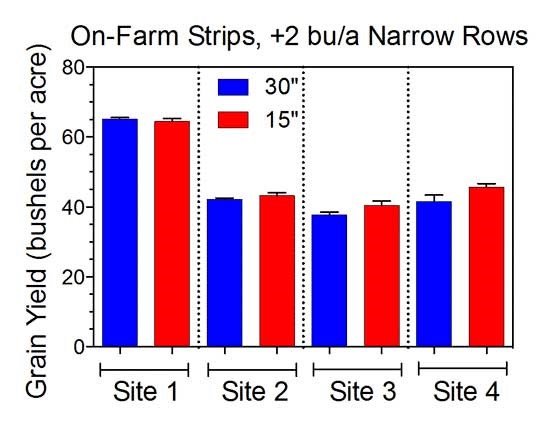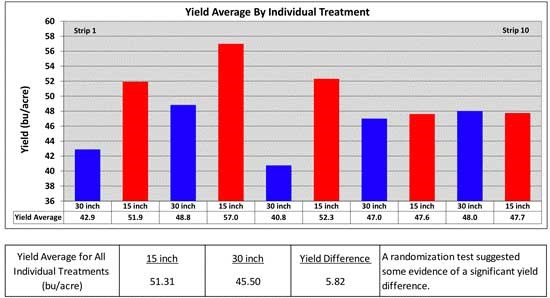There are still many questions about row spacing for soybean production. Research from K-State has found that narrow rows (15-inch or 7.5-inch) result in equal or greater yields compared to 30-inch rows when the yield environment is greater than 45-50 bushels per acre (regardless of planting date, seeding rate, or maturity). Below this yield threshold level, narrow rows tend to result in yields about equal to or slightly below (depending on the water status, the drier the less benefit for narrow rows) yields in 30-inch row spacing. Narrow rows have several benefits such as early canopy cover, better light capture, improved weed control, and reduced erosion. Poor stands, however, are more common with narrow row spacing versus wider row spacing.
For the last seasons, on-farm studies (collaboration between K-State, Kansas Soybean, North Central Soybean Research Program, and the United Soybean Board - USB) showed slight yield improvement (+2 bushels per acre) on narrow rows (15-inch; Figure 1) with yields averaging 48 bushels per acre.
Overall Summary

Figure 1. Soybean yield (bushels per acre) by row spacing for conventional (30-inch) versus narrow (15-inch) configuration. Graph by Ignacio Ciampitti, K-State Research and Extension.
For the 2017 season, two studies (collaboration between K-State, Kansas Soybeans, North Central Soybean Research Program) were conducted comparing 15 vs. 30-inch rows. The first study was located in Franklin County, Kansas (Figure 2) and the second one was located in Riley County, Kansas (Figure 3).

Figure 2. Soybean yield (bushels per acre) by row spacing for conventional (30-inch) versus narrow (15-inch) configuration, in Franklin County, Kansas. K-State Research and Extension.

Figure 3. Soybean yield (bushels per acre) by row spacing for conventional (30-inch) versus narrow (15-inch) configuration in Riley County, Kansas. K-State Research and Extension.
Overall, narrow rows provided a yield response ranging from -0.6 to +5.0 bu/acre. An additional benefit for narrow rows was enhanced early light interception and improved weed control.
Ignacio Ciampitti, Farming Systems
ciampitti@ksu.edu